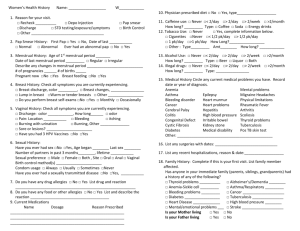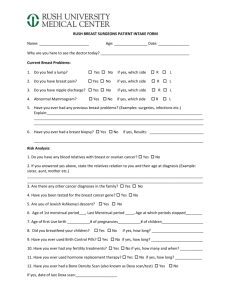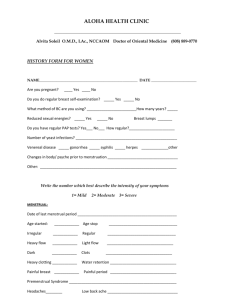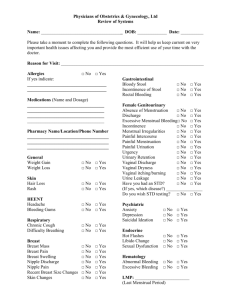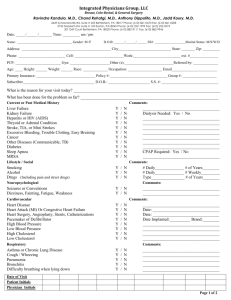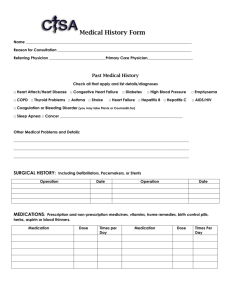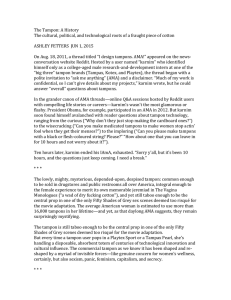Menstrual Cycle Diary instructions - The Centre for Menstrual Cycle
advertisement
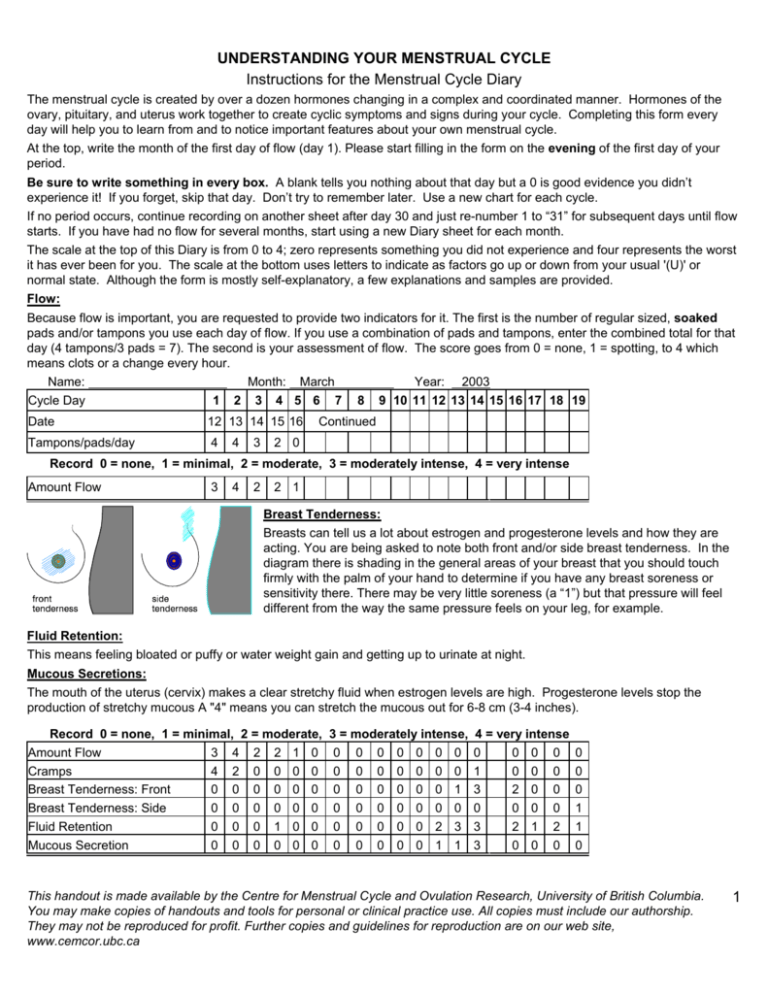
UNDERSTANDING YOUR MENSTRUAL CYCLE Instructions for the Menstrual Cycle Diary The menstrual cycle is created by over a dozen hormones changing in a complex and coordinated manner. Hormones of the ovary, pituitary, and uterus work together to create cyclic symptoms and signs during your cycle. Completing this form every day will help you to learn from and to notice important features about your own menstrual cycle. At the top, write the month of the first day of flow (day 1). Please start filling in the form on the evening of the first day of your period. Be sure to write something in every box. A blank tells you nothing about that day but a 0 is good evidence you didn’t experience it! If you forget, skip that day. Don’t try to remember later. Use a new chart for each cycle. If no period occurs, continue recording on another sheet after day 30 and just re-number 1 to “31” for subsequent days until flow starts. If you have had no flow for several months, start using a new Diary sheet for each month. The scale at the top of this Diary is from 0 to 4; zero represents something you did not experience and four represents the worst it has ever been for you. The scale at the bottom uses letters to indicate as factors go up or down from your usual '(U)' or normal state. Although the form is mostly self-explanatory, a few explanations and samples are provided. Flow: Because flow is important, you are requested to provide two indicators for it. The first is the number of regular sized, soaked pads and/or tampons you use each day of flow. If you use a combination of pads and tampons, enter the combined total for that day (4 tampons/3 pads = 7). The second is your assessment of flow. The score goes from 0 = none, 1 = spotting, to 4 which means clots or a change every hour. Name: Month: March Year: 2003 Cycle Day 1 2 3 4 5 6 7 8 9 10 11 12 13 14 15 16 17 18 19 Date 12 13 14 15 16 Tampons/pads/day 4 4 3 Continued 2 0 Record 0 = none, 1 = minimal, 2 = moderate, 3 = moderately intense, 4 = very intense Amount Flow 3 4 2 2 1 Breast Tenderness: Breasts can tell us a lot about estrogen and progesterone levels and how they are acting. You are being asked to note both front and/or side breast tenderness. In the diagram there is shading in the general areas of your breast that you should touch firmly with the palm of your hand to determine if you have any breast soreness or sensitivity there. There may be very little soreness (a “1”) but that pressure will feel different from the way the same pressure feels on your leg, for example. Fluid Retention: This means feeling bloated or puffy or water weight gain and getting up to urinate at night. Mucous Secretions: The mouth of the uterus (cervix) makes a clear stretchy fluid when estrogen levels are high. Progesterone levels stop the production of stretchy mucous A "4" means you can stretch the mucous out for 6-8 cm (3-4 inches). Record 0 = none, 1 = minimal, 2 = moderate, Amount Flow 3 4 2 2 1 0 Cramps 4 2 0 0 0 0 Breast Tenderness: Front 0 0 0 0 0 0 Breast Tenderness: Side 0 0 0 0 0 0 Fluid Retention 0 0 0 1 0 0 Mucous Secretion 0 0 0 0 0 0 3 = moderately intense, 0 0 0 0 0 0 0 0 0 0 0 0 0 0 0 0 0 0 0 0 1 0 0 0 0 0 0 0 0 0 0 0 0 2 3 0 0 0 0 0 1 1 4 = very intense 0 0 0 0 1 0 0 0 3 2 0 0 0 0 0 0 3 2 1 2 3 0 0 0 0 0 0 1 1 0 This handout is made available by the Centre for Menstrual Cycle and Ovulation Research, University of British Columbia. You may make copies of handouts and tools for personal or clinical practice use. All copies must include our authorship. They may not be reproduced for profit. Further copies and guidelines for reproduction are on our web site, www.cemcor.ubc.ca 1 Headache: The score in this box is for any old ordinary kind of headache. However, if it was a migraine, put a small star or dot in the box as well as the score. Feelings and Outside Stresses: You are asked to record how you feel each day using a 0-4 scale on the top section of the form. In addition, we would like you to evaluate the amount of outside stress in your life (Stress - work, home, etc). These two things are sometimes different - your day may have been awful but you can still feel good about yourself and not depressed or anxious. Please write your comments at the bottom of the column. This may include any particular event that influenced how you felt that day (eg illness, a job promotion, winning a lottery, argument with partner). Record M = much less, L = a little less, U = usual, Y = a little increased, Z = much increased Appetite L U U U U Breast Size U U U Y Y Interest in sex L U U Y U Stress - work, home, etc L L U U Y Quantitative Basal Temperature (QBT) Monitoring: (called this because we use statistics to decide where the temperature increase occurs—Prior, Clinical Invest. Med., 1990). Progesterone makes the first morning temperature increase a small but reliable amount. The following recommendations will assist you to accurately take and record your oral temperature. 1. Day 1 is the first day of your flow (and you should be starting on a new sheet). 2. Take your temperature in the morning, when you first wake. 3. Activity will raise your basal (resting) temperature. Although you may start your thermometer and head to the washroom, if you can, postpone this or getting out of bed until your temperature taking is finished. 4. Under 'Comments', please record any events that may affect your morning temperature (the time if you slept in or got up early, felt like you were getting the flu or had a very late night). Using the digital thermometer: 1. Press the ON/OFF button and a beep will sound (88.88 will display when the thermometer is used for the first time). 2. After a few seconds the display will go blank. 3. Place the thermometer under your tongue. 4. When the peak temperature is reached (in about 1 minute), a beep will sound 3 times. The reading will not change while the power remains on. 5. Turn the thermometer off by pressing the green ON/OFF button. The reading will be stored in memory for 3 seconds the next time you switch the thermometer on. After 3 seconds, the display will go blank and the temperature will be permanently erased from memory. Analyzing your temperature data: If you would like to figure out whether you have ovulated and the length of your luteal phase (the time following ovulation) you can do that. First, compute the average of all the temperatures in your record, by adding them up and dividing by the number of days for which you have temperature readings. The average temperature you get can then be compared with the actual readings. If your temperature went above and stayed above that average until the day before the next flow you have ovulated. The higher temperatures should last 10-16 days. When there are between 3 and 9 days of higher temperatures, you have what is called a short luteal phase. This means that you have ovulated but the time of progesterone elevation is too short. Enjoy the keeping of this daily Menstrual Cycle Diary and quantitative basal temperature record. You will learn new things about yourself! Version date: August 29, 2003. Dr JC Prior© 1991, 2002 This handout is made available by the Centre for Menstrual Cycle and Ovulation Research, University of British Columbia. You may make copies of handouts and tools for personal or clinical practice use. All copies must include our authorship. They may not be reproduced for profit. Further copies and guidelines for reproduction are on our web site, www.cemcor.ubc.ca 2
